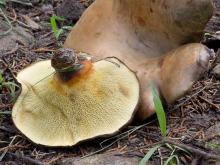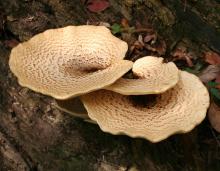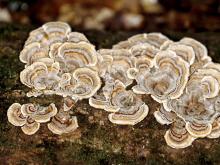Mushrooms
Media

Species Types
Scientific Name
Boletinellus merulioides
Description
The ash tree bolete is a pored mushroom with a brownish, wavy cap, an off-center stalk, and clearly defined pores. It grows scattered on the ground near ash trees.
Media

Species Types
Scientific Name
Ganoderma sessile (formerly G. lucidum)
Description
The ling chih is a hard, usually flat, zoned bracket fungus with a reddish brown, shiny top. It grows at the base of living and dead deciduous trees, and also around stumps.
Media

Species Types
Scientific Name
Polyporus squamosus
Description
The dryad's saddle is a large, fleshy, scaly, yellowish tan bracket fungus with large, yellowish white pores and a short stalk; it smells like watermelon rind. It grows singly or in layers, on living or dead deciduous wood.
Media

Species Types
Scientific Name
Trametes versicolor
Description
Turkey tail grows in clusters of leathery, thin brackets with multicolored zones above and whitish yellow pores below. Look for it on stumps and logs of deciduous trees.
Media

Species Types
Scientific Name
Lenzites betulina
Description
Multicolor gill polypore is a bracket fungus with a semicircular, tough, hairy, multicolored, zoned cap; beneath, it's white, with leathery, gill-like tubes. It grows on dead deciduous wood.
Media

Species Types
Scientific Name
Grifola frondosa
Description
Looking like a ruffled chicken, the edible hen of the woods mushroom grows like large circular bouquet of spoon-shaped caps, each grayish brown on top and white beneath, emerging from a branching, whitish base. It grows on the ground at the base of oak trees.
Media

Species Types
Scientific Name
Meripilus sumstinei (formerly M. giganteus)
Description
The black-staining polypore grows in large, circular clusters of many fleshy, grayish yellow, fan-shaped caps, which bruise black when cut or touched. It grows on the ground around deciduous trees, especially oaks.
Media

Species Types
Scientific Name
Polyporus radicatus
Description
The rooting polypore has a scruffy, tough, yellowish-brown cap with whitish-yellow pores, and a stalk with a long, black, rootlike filament. It usually grows singly, on the ground near stumps or attached to buried roots.
Media

Species Types
Scientific Name
Gymnosporangium juniperi-virginianae
Description
With their gelatinous orange tentacles, cedar-apple rust galls are one of Missouri’s freakiest sights in spring. Cedar-apple rust is a fungus with a two-part life cycle. Its two unrelated host plants are a juniper, such as eastern red cedar, and a tree in the rose family, especially apple and crabapple.
See Also



Media

Species Types
Scientific Name
Monotropa hypopitys
Description
Pinesap is a plant that puts the "wild" in wildflower! It lacks chlorophyll, so its roots connect to fungi underground and absorb nutrients from the fungi.
Media

Species Types
Scientific Name
Cladophora, Pithophora, and Spirogyra spp., and others
Description
Filamentous green algae forms green, cottony masses that are free-floating or attached to rocks, debris, or other plants.
Media

Species Types
Scientific Name
Monotropa uniflora
Description
Indian pipe lacks chlorophyll, so it is white, not green. Below ground, its roots join with fungi that connect to tree roots. This plant, then, takes nourishment indirectly from the trees.
About Mushrooms in Missouri
Mushrooms are a lot like plants, but they lack chlorophyll and have to take nutrients from other materials. Mushrooms are neither plants nor animals. They are in a different kingdom — the fungi. Fungi include the familiar mushroom-forming species, plus the yeasts, molds, smuts, and rusts.
Always be cautious when eating edible mushrooms. Be absolutely sure of the ID, and only eat a small amount the first time you try it to avoid a reaction..





















